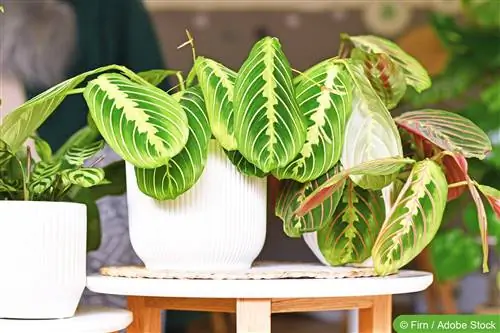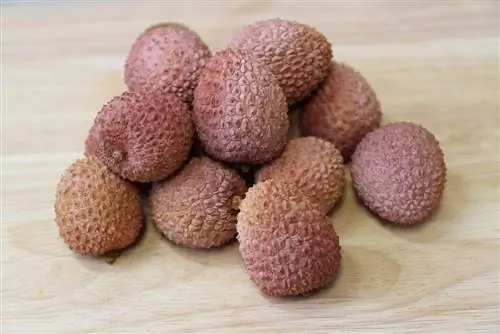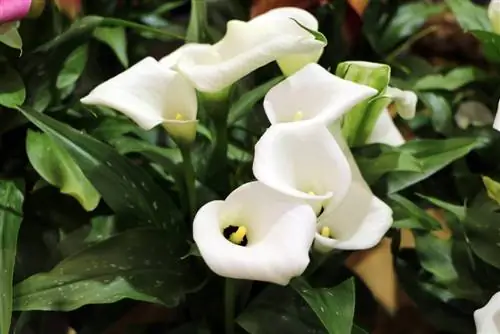- Author admin [email protected].
- Public 2023-12-17 03:39.
- Last modified 2025-01-24 12:45.
The arrowroot belongs to the arrowroot family. The plants grow between 10 cm and 60 cm tall and are native to South America. The leaves grow from a short, inconspicuous stem and, with their bone-shaped pattern, form this extraordinary houseplant. The name arrowroot comes from the arrow-shaped, pointed leaves, which can easily change their shape.
Care tips for arrowroot
You should generally have a green thumb for arrowroot. Although it doesn't require too much attention, the houseplant still has some peculiarities that you should definitely take into account when caring for it.
Location
The location of the houseplant is very important because the arrowroot does not tolerate direct sunlight. If you still want to place the arrowroot in a window on the south side, you should create an artificial partial shade. This works, for example, if you place another houseplant in front of the arrowroot so that sunlight cannot fall directly on the leaves, or you put up a light or thin curtain on the window, which should be closed when the sun is shining.
Watering the plant
While the arrowroot is in the growth phase, you should water it regularly. It is important to ensure that the soil never completely dries out. The best thing for arrowroot is constant moisture, which you can get under control after a while. Just as arrowroot cannot tolerate the root ball drying out, it is also very sensitive to waterlogging. It would be advisable to dip the pot into a bucket of water, take it out again and then let it drain for a few hours, without a saucer. This allows the excess water to drain away again through the holes at the bottom of the flower pot. Furthermore, you should not water the arrowroot with drinking water or hard water, but rather with rainwater.
Suitable temperature
Arrowroot is very sensitive to temperature. The houseplant feels most comfortable at a temperature between 20° Celsius and 25° Celsius. If the temperature rises above this range in the summer months, you should spray the arrowroot with a spray bottle containing rainwater so that it can cool down. However, the temperature must not fall below the 15° Celsius mark, because the arrowroot is not resistant to these temperature fluctuations.
Soil and fertilizer
For the arrowroot to thrive, the soil should consist of a quarter of peat and three quarters of leaf mold and compost. The houseplant should be supplied with nutrients at regular intervals of four weeks by adding liquid fertilizer. In the period between September and February, the arrowroot goes into a growth pause. During this time, a single addition of liquid fertilizer is sufficient.
Propagate arrowroot
If you want to decorate your home with several houseplants of this type, the arrowroot must be divided. However, this should only be used in spring. The arrowroot is taken out of the pot and divided with a little effort. There must be some roots visible on every part of the arrowroot so that it can grow he althily.
Arrowroot Diseases
The arrowroot can attract spider mites, which multiply quickly on the houseplant. If this is the case, you should contact a gardener. They often have advice on what to do to get rid of these spider mites. When changing location, the following symptoms can be typical:
- Leaves that curl up from the edge,
- Leaves that turn brownish,
- fading of leaves or
- Spots on the leaves.
If the leaves curl up from the edge, this is usually a sign that the root ball is too dry and the plant is about to die of thirst. Therefore, you should water the houseplant immediately. If the leaves turn brownish, this could also be a sign that the arrowroot is either too dry or perhaps too wet and waterlogging has formed in the planter. If the arrowroot reacts with these symptoms, the moisture of the soil should be tested before watering.
The leaves of the arrowroot could also bleach. If this sign is seen, it would be highly recommended that the arrowroot be relocated to another location. The sunlight is too direct here. Shading should definitely be provided here.
If the leaves of the arrowroot get spots, this is largely a sign of calcareous water. In this case, it is advisable to set up a barrel to collect the rainwater. Rainwater is lime-free and ideal for watering the arrowroot.
If the leaves of the arrowroot roll up in the evening and unfurl again in the morning, this is not an illness, but simply a sleeping behavior of the arrowroot. The houseplant reduces the area in order to prevent evaporation at night.
What you should know about arrowroot in brief
The Maranta leuconeura is an attractive ornamental plant from Brazil and belongs to the marantaceae family, which includes 32 different species. It has an exceptionally beautiful leaf pattern in several different colors.
- Due to its subtropical origins, arrowroot requires high humidity and consistent warmth. Therefore, in our region it often thrives in greenhouses and plant display cases.
- The location must be bright, but the arrowroot cannot tolerate direct sunlight. The soil temperature is ideally around 20 degrees Celsius. In winter the room temperature can be slightly lower, but not below 14 degrees Celsius.
- Watering should, if possible, be done with rainwater at a moderate temperature. If there is no rainwater, the tap water can be softened.
- The root ball must be kept evenly moist. It must neither dry out nor be watered too much, as the plant is very sensitive and cannot tolerate this.
- Once a year the arrowroot should be transplanted into a slightly larger pot. Don't just use a larger pot, but just the next size up from the planter so that the arrowroot can grow upwards.
In summer, the arrowroot is fertilized every two weeks; special fertilizer for green plants is suitable for this. Young plants and newly acquired plants are fertilized for the first time after eight weeks. If the arrowroot Maranta leuconeura is grown as a houseplant, evaporation containers should be set up to increase the humidity. Regular spraying of the leaves is also important. If the distinctive leaf pattern disappears, this is a sign that the arrowroot is in a place that is too dark. Drafts should generally be avoided.
- Propagation is possible by dividing the root ball and using top cuttings. To propagate by top cuttings, cut a cutting with four leaves and place it in a small pot.
- A mixture of peat and sand is suitable as a substrate for cultivation. If the soil is kept evenly moist and warm, the roots will sprout after about four to six weeks.






